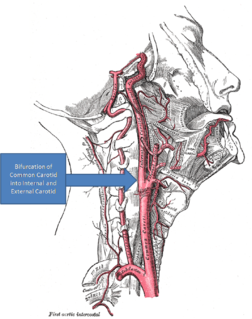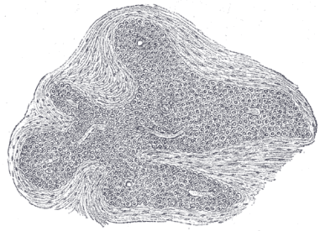Glomerulus is a common term used in anatomy to describe globular structures of entwined vessels, fibers, or neurons. Glomerulus is the diminutive of the Latin glomus, meaning "ball of yarn".

The temporal bones are situated at the sides and base of the skull, and lateral to the temporal lobes of the cerebral cortex.

The carotid body is a small cluster of chemoreceptor cells, and supporting sustentacular cells. The carotid body is located in the adventitia, in the bifurcation (fork) of the common carotid artery, which runs along both sides of the neck.

Angiomas are benign tumors derived from cells of the vascular or lymphatic vessel walls (endothelium) or derived from cells of the tissues surrounding these vessels.

A paraganglioma is a rare neuroendocrine neoplasm that may develop at various body sites. When the same type of tumor is found in the adrenal gland, they are referred to as a pheochromocytoma. They are rare tumors, with an overall estimated incidence of 1/300,000. Unlike other types of cancer, there is no test that determines benign from malignant tumors; long-term follow-up is therefore recommended for all individuals with paraganglioma.

A glomus tumor is a rare neoplasm arising from the glomus body and mainly found under the nail, on the fingertip or in the foot. They account for less than 2% of all soft tissue tumors. The majority of glomus tumors are benign, but they can also show malignant features. Glomus tumors were first described by Hoyer in 1877 while the first complete clinical description was given by Masson in 1924.
A glomus body is a component of the dermis layer of the skin, involved in body temperature regulation. The glomus body consists of an arteriovenous shunt surrounded by a capsule of connective tissue. Glomus bodies are most numerous in the fingers and toes. The role of the glomus body is to shunt blood away from the skin surface when exposed to cold temperature, thus preventing heat loss, and allowing maximum blood flow to the skin in warm weather to allow heat to dissipate. The glomus body has high sympathetic tone and potentiation leads to near complete vasoconstriction.

Glomus cells are the cell type mainly located in the carotid bodies and aortic bodies. Glomus type I cells are peripheral chemoreceptors which sense the oxygen, carbon dioxide and pH levels of the blood. When there is a decrease in the blood's pH, a decrease in oxygen (pO2), or an increase in carbon dioxide (pCO2), the carotid bodies and the aortic bodies signal the dorsal respiratory group in the medulla oblongata to increase the volume and rate of breathing. The glomus cells have a high metabolic rate and good blood perfusion and thus are sensitive to changes in arterial blood gas tension. Glomus type II cells are sustentacular cells having a similar supportive function to glial cells.

The tympanic nerve is a branch of the glossopharyngeal nerve found near the ear.
Glomus is a genus of arbuscular mycorrhizal (AM) fungi, and all species form symbiotic relationships (mycorrhizas) with plant roots. Glomus is the largest genus of AM fungi, with ca. 85 species described, but is currently defined as non-monophyletic.

The coccygeal glomus is a vestigial structure placed in front of, or immediately below, the tip of the coccyx.

A paraganglion is a group of non-neuronal cells derived of the neural crest. They are named for being generally in close proximity to sympathetic ganglia. They are essentially of two types: (1) chromaffin or sympathetic paraganglia made of chromaffin cells and (2) nonchromaffin or parasympathetic ganglia made of glomus cells. They are neuroendocrine cells, the former with primary endocrine functions and the latter with primary chemoreceptor functions.
Glomangiosarcoma is a low grade tumor of the soft tissue. They rarely metastasize, but metastases are possible. It is also known as "malignant glomus tumor". Positive staining for vimentin has been reported.
Phytoscutus is a genus of mites in the family Phytoseiidae.
Phytoscutus acaridophagus is a species of mite in the family Phytoseiidae.
Phytoscutus gongylus is a species of mite in the family Phytoseiidae.
Phytoscutus reunionensis is a species of mite in the family Phytoseiidae.
Phytoscutus sexpilis is a species of mite in the family Phytoseiidae.

Rhizophagus irregularis is an arbuscular mycorrhizal fungus used as a soil inoculant in agriculture and horticulture. In addition, it is one of the best mycorrhizal varieties of fungi available to mycoforestry, but as it does not produce fruiting bodies it "has virtually no market value as an edible or medicinal mushroom"









